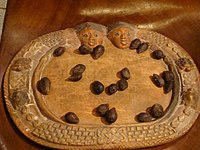In Yoruba mythology, Oya (Alternative spellings: Oiá, Iansã, Iansan), is the Undergoddess of the Niger River. Oya has been syncretized in Santeria with the Catholic images of the Virgin of Candelaria.
Aspects[]
She is seen in aspects as the warrior-spirit of the wind, lightning, fertility, fire, and magic. She creates hurricanes and tornadoes, and guards the underworld.[1] Spirit of tornadoes (which are said to be her whirling skirts as she dances), lightning (the power of which she acquired from her husband, Shango), earthquakes, and any kind of destruction. Beyond destruction, Oya is the spirit of change, transition, and the chaos that often brings it about. Her association with the marketplace, and more specifically with the gates of cemeteries (as opposed to the entire underworld), reveals her in her aspect as facilitator of transition. Oyá, when danced, often has a horse tail. Her clothes have all the colors but black. She has a face expression of really big and open eyes, and she breathes and blows up her chins, and often screams.
Oya's close association with the passage from life into death also means she is one of the few Orishas which are worshiped alongside the Egun ancestors, whose cult is most often distinct from that of the Orishas. In the stories of the faith, she can transform herself into a water buffalo. One of her preferred offerings is the eggplant.
Name[]
In Yoruba, the name Oya literally means "She Tore".[2] She is known as Oya- Iyansan,Oya - the "mother of nine." This is due to the Niger River (known to the Yoruba as the Oya) traditionally being known for nine tributaries. In Brazil, in Candomble, she is generally saluted with the phrase "Èpa heyi!. while in Cuban-derived Yórùbá traditions, the faithful often salute her by saying "Hekua hey Yansa."
Connection to Other Orishas[]
She is closely associated with many Orishas, but most especially Chango, Oggun, Oba (Obba), Yewá/Euá and Ochún/Oxum. Oya is believed to have been Shango's favorite wife. She is also called "the one who puts on pants to go to war" and "the one who grows a beard to go to war".
As the deity of the wind, Oya manifests in Creation in the forms of sudden and drastic change, strong storms, and the flash of the marketplace. Her representation of natural disasters and death is not as arbitrary as it may seem, these factors often serving as a means of creation for her.
Oya is said to have a sister named Ayao who is received by some of her initiates. The ritual and existence of Ayao is questionable, and it is hard to trace her origins outside of the Lukumi system. Ayao is mentioned in books by Lydia Cabrera and surfaced in the United States in the mid-nineties (1994–1995).
Syncreticism[]
Oya has been syncretized in Santeria with the Catholic images of the Our Lady Of Candelaria (Saint Patron of the Canary Islands in Spain) and St. Theresa. Her feast day is February 2.
Notes[]
See also[]
- Woman warrior
- List of women warriors in folklore
References[]
- OYA, Judith Gleason, Harper, San Francisco, 1992 (Shamballah, 1987), ISBN 0-06-250461-4
- Charles Spencer King.,"Nature's Ancient Religion" ISBN 978-1440417337
External links[]
| ||||||||||||||||||||||||
| ||||||||||||||||||||||||||||||||||||||||||||
| This Creative Commons Licensed page uses content from Wikipedia (view authors). The text of Wikipedia is available under the license Attribution-Share Alike 3.0 Unported (ToU). |
